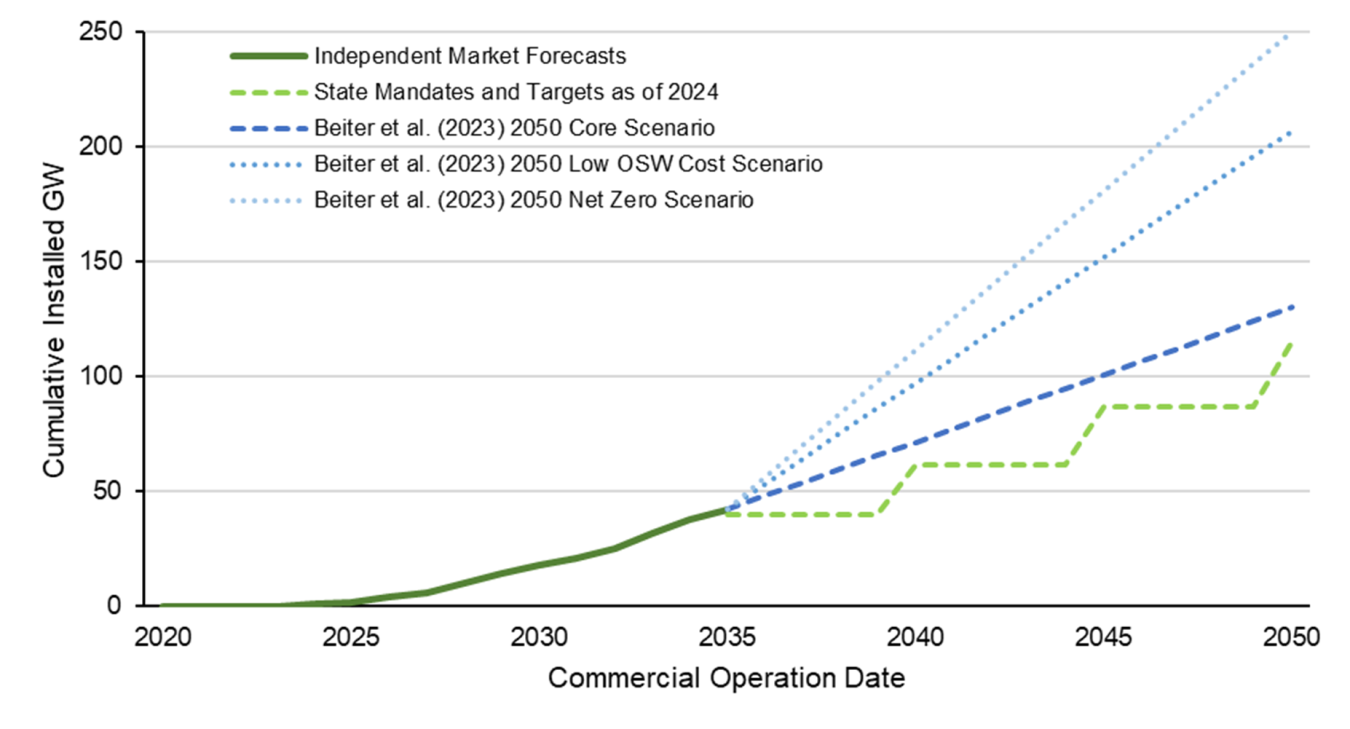Originally announced in April 2024 at the International Partnering Forum in New Orleans, the Pathways to Commercial Liftoff: Offshore Wind report outlines how the U.S. offshore wind industry can play a critical role in both near- and long-term decarbonization of the U.S. energy system.
Office of Technology Transitions
June 12, 2024Originally announced in April 2024 at the International Partnering Forum in New Orleans, the Pathways to Commercial Liftoff: Offshore Wind report outlines how the U.S. offshore wind industry can play a critical role in both near- and long-term decarbonization of the U.S. energy system.
Offshore Wind is the ninth sector tackled by the Pathways to Commercial Liftoff effort, a set of reports quarterbacked by DOE’s Office of Technology Transitions. The reports provide the private sector, State governments, and energy industry partners a valuable, engagement-driven resource on how and when certain technologies can reach full-scale deployment. The initiative underscores the critical role that DOE plays in enabling widespread commercial adoption of the clean energy technologies that are essential to meeting President Biden’s ambitious goals of achieving 100% clean electricity by 2035 and a net-zero emissions economy by 2050.
The potential for offshore wind in the United States is massive. With over 4,200 GW of technical resource potential, offshore wind could meet today’s U.S. electricity demands more than three times over.6 7 As a resource, offshore wind displays high-capacity factors and strong winter production that support grid reliability and resource diversity, offering a compelling and distinctive value proposition that complements other clean resources. Offshore wind will play a key role in decarbonizing coastal population centers and provides an opportunity to revitalize maritime infrastructure and domestic manufacturing.
Today, the U.S. offshore wind market is at an inflection point. Despite recent macroeconomic challenges, the sector is adapting, and improved risk mitigation is being built into industry planning. U.S. offshore wind is now poised for Liftoff, beginning with the 10–15 GW of projects with a path to final investment decision in the next few years. These projects will lay the foundation for consistent long-term deployment, decarbonization, and economic benefit across the country. Longer term, offshore wind can deliver over 100 GW clean power by 2050.

The fixed-bottom wind market is closer to liftoff, with phase 1 on track, phase 2 underway, and phase 3 soon to follow. The floating wind market is earlier stage; its path to liftoff requires early planning for infrastructure (ports, assembly yards, transmission), establishing demand frameworks, and adaptive ecosystem management. These actions can be taken now to help keep active U.S. developments on-track and unlock floating wind as a tool for U.S. decarbonization.
Across both fixed-bottom and floating wind markets, enabling infrastructure is key. The availability of ports and vessels will set the annual deployment potential of the U.S. market, and the industry will need widespread expansion across component supply chains to support growing demand. Transmission buildout is a major component: Offshore wind projects face interconnection risks and cost challenges today, and long-term planning can de-risk future deployment and help build a more resilient and efficient grid.
The Pathways to Commercial Liftoff: Offshore Wind report addresses four major challenges the industry must overcome to achieve liftoff, many of which already have some solutions underway.
| Challenge | Solutions Underway |
| 1. Recent offtake cancellations, driven by macroeconomic conditions, create timing uncertainty and funding gaps for sector buildout. |
|
| 2. Current market structures expose the sector to exogenous risks and require early mover projects to carry the costs and execution complexity of long-term industry buildout needs. |
|
| 3. Industry lacks market visibility to plan long-term investment cases, especially for supply chain needs. |
|
| 4. Transmission risks development bottlenecks and grid inefficiencies via onshore interconnection, offshore project design, and wider network buildout. |
|
The U.S. offshore wind sector today is poised for liftoff, beginning with the 10-15 GW of projects with a path to reach FID in the next few years. The path to long-term cost reductions begins with deploying a critical mass of projects today. These projects will lay the foundation for consistent long-term deployment, decarbonization, and economic benefit across the country.
Register here for the June 25th webinar to learn more about the Pathways to Commercial Liftoff: Offshore Wind report and hear from DOE leadership about the importance of building a domestic offshore wind industry.
In line with its living document philosophy, the DOE will continue to revise and update the Liftoff Reports as the technology and policy landscape evolves. Public input and stakeholder engagement continue to be encouraged through industry forums and can be submitted via email to [email protected].
The Pathways to Commercial Liftoff Reports were developed through extensive stakeholder engagement and a combination of system-level modeling and project-level financial modeling. Additional reports will be published in the coming weeks and months. Find more information about and read the full reports here.

